#also 'get some new material champ' is from the made for tv it movie from the 90s i tried to find a gif but couldnt rip
Explore tagged Tumblr posts
Text
saw someone complaining about how the klaine fandom is just as toxic as it was in 2012 and then concluded with the ol faithful "klaine is the gay ship for the straights" like goddamn talk about get some new material champ
#the funny thing is it wasnt even about the actual 'anti blaine' discourse that just popped up#it was bc of some people talking about k & j's podcast like???#im up the klaine fandom's butt and yet im capable of not paying that any attention bc i just dc about the podcast lmao#seems like itd be even easier for them to avoid it if they wanted to#but what do i know#also 'get some new material champ' is from the made for tv it movie from the 90s i tried to find a gif but couldnt rip#glee#klaine#delete later
13 notes
·
View notes
Text
I watched all 26 episodes of an obscure Australian cartoon in one week and I’m not okay - My journey with Wicked! (2001) PART 1

Here it is, the reason I started this blog in the first place. I need to talk about this cartoon I ran into completely by chance.
It all started, like you would, with Tubitv.
Good ol’ Tubi, the free streaming service that makes you either an expert at being able to find diamonds in piles of garbage or a connoisseur of said garbage. It’s thanks to Tubi that I put down that I watched Alpha and Omega: Family Vacation on Letterboxd for all to see and judge, but it’s also thanks to Tubi that I finally ended up watching Killer Klowns from Outer Space.
Anyhoo, one day I was browsing their family film selection when I ran into this selection. And that was the day my life changed forever.
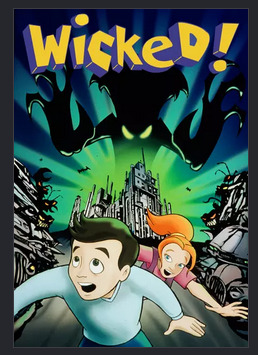
What you see before you, posted to a streaming service accessible in the United States, is the movie adaptation of an Australian TV show that never made it to the United States, which is based off a series of Australian children’s books from the 90′s that also never made it to the United States. It made it to other territories like Germany and the United Kingdom (and it apparently did super well in France but don’t quote me on this) but the TV show ran for one year and then disappeared without a trace after one 26 episode season.
How obscure is this franchise? Well, for starters, at the time I’m writing this in 2020, the books, the TV show, and the movie all don’t have a single Wikipedia page to call their own, and the easiest way to get info about this thing is to find the (rather tiny) TvTropes page.
Let’s just get right into this shall we.
What is Wicked!?
Before you try to be all cute and make any references to the hit musical, there’s a reason I’m putting that exclamation mark there.
Wicked! started out as a series of six children’s books written by Paul Jennings and Morris Gleitzman. I actually grabbed a kindle copy of all six books (because I’m in this thing too deep and I wanted to see how the cartoon compared with the source material) and I gotta say, they’re very charming.
The best way I can describe them is that they’re in the kid horror genre, but they’re less Goosebumps and more The Weenies book series by David Lubar in terms of gore and child endangerment. Wicked! has some artful depictions of blood and gore, but in a way that can be digested by the grade school crowd.
Being a former child, I can proudly proclaim that I would’ve adored this series when I was younger. Just look at these covers!
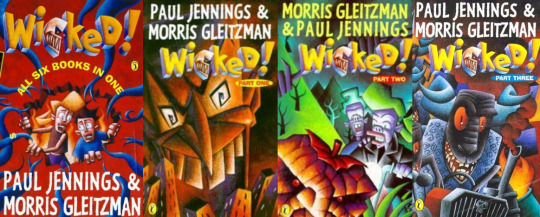
The plot of the books is that there’s a widower with a daughter and a divorced wife with a son who get married, and the two new step-siblings Rory and Dawn absolutely hate each other. They can’t stand the fact that their parents are getting married! Gross!
But then, on the day of their wedding, creepy things begin to happen after Rory receives an appleman doll in the mail, and then, over the course of six books, a deadly single-minded virus that feeds on hate and is targeting Rory’s bloodline begins to spread across wildlife, creating crazed mutant animals that try to kill everyone in the household. It’s up to Rory, Dawn, and Dawn’s grandfather Gramps to stop this virus before it kills Rory and his mother, and to do so, they have to seek out Rory’s father, who seems to be the mysterious cause and/or the solution to the virus.
I’m not sure how well these books did, on account of the whole “not Australian” affliction I seem to suffer from, but they seemed to do well enough to get a TV show adaptation.
And surprisingly, the TV show is a very close adaptation of the books, only they changed the plot in two big ways so that it fits an animated series with a “monster of the week” setup.
The first big change was that, of course, they toned down the blood and gore and removed the deadliness of the virus, choosing to go with a more cartoony mutagenic approach. Rory gets infected by the virus several times in the show, just like how he does in the books, but unlike the books, he never thinks that he’s going to die from it and it’s definitely treated as a more temporary thing. There’s no race against time either. Everyone is trying to live their lives except every so often, the virus shows up. A wacky cartoon virus with cartoony stakes.
That brings me to the other main change that they make in the show. Unlike the books, where the main villain is a mindless virus that feeds off of hate, an invisible foe that can only be defeated at the end of the last book with the help of Rory’s father, the TV show decides that that’s no fun and instead makes a main villain out of one of the main plot points in the books. Say hello to The Appleman. (Apple-Man? Apple Man? Fuck it, I’m going with the first one from now on)
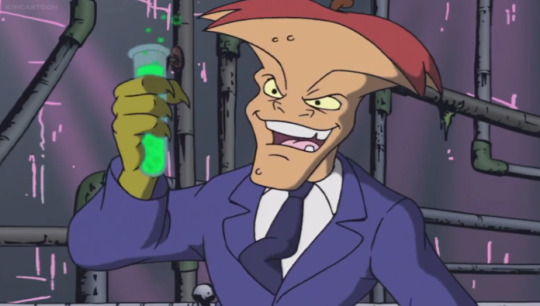
Instead of having the virus mutate mysteriously and having the main characters constantly hypothesize what’s going to happen next, the TV show made a main villain who constantly reinvents new strains of virus in a laboratory that he set up in an abandoned refinery.
What then happens is a basic plot set-up that the show follows pretty consistently in every episode. The family is trying to do something, we get the theme for the episode, and The Appleman, who is a spiteful bastard who is trying to ruin this one family in particular (and I’ll get to that), decides to make a virus that will infect the theme of that episode.
Pretty standard cartoon stuff, right? Ah, but then you don’t realize the beauty of this show. But first, I gotta introduce the main stars of this show.
The Characters
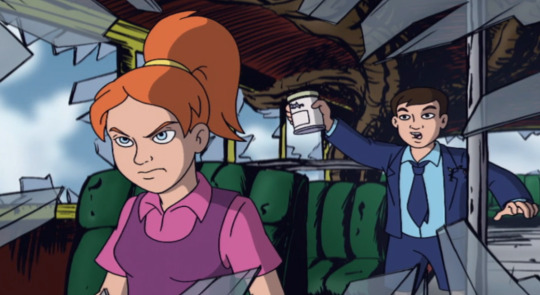
(quick note: this bus is incredibly important to the plot, but only in the books)
First we have Rory (the boy holding up the tin) and Dawn (the mad red head).
Dawn is the step-sister who lost her mom, a bus driver, in a gruesome bus accident, Rory is the step-brother whose parents got a divorce and then his dad went missing, believed to have run away from his whole family. Both of them are meant to be the dual protagonists, but I feel that there’s just a tiny bit more focus on Rory. There’s a reason for this that I will mention later.
What is interesting to note is that they make Rory the smart, non-athletic little nerd that gets picked on a lot at school for being a dork while Dawn loves sports, is failing science, gets made fun of for not being as girly as the other girls in her class, and likes violent computer games. I wouldn’t exactly call them “fleshed out” but they did enough to make these kids feel like actual kids.
Also, they fight. Constantly. This is the main complaint of anyone who actually looks into this show judging by my brief skimming of Internet comments because these two constantly bicker and insult each other and that makes up like 40% of the dialogue in any given episode. While this is one of the main story conflicts and they’re like this in the books too, it just feels super exhausting to see these two constantly at each other’s throats in every single episode.
They get mean too. Which, surprisingly, makes them both more realistic (I babysat multiple times and kids can be pretty verbally awful to each other) while also making them just a tiny bit unbearable at times. Here’s some actual dialogue.
"My dad sent it to me!" "Gee, he must think a lot of you to send you a doll full of worms." "Your mum thought so much of you she drove this bus over a cliff and into the river to get away from you."
GEEZ, guys...
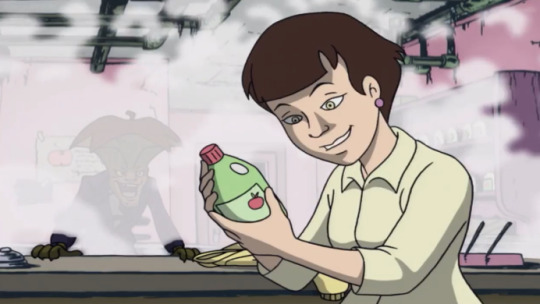
Eileen, Rory’s mom.
It feels out of the three adults in the family, she gets the least amount of character development, but she does get a fair amount of screentime, so you can’t really say they’re intentionally ignoring her. She divorced her previous husband and works as a mail courier. Instead of owning a car, she drives a motorcycle, and, in the first episode, even drives it to her own wedding while dressed in a bridal gown. Rory’s mom rules.
She tries to bond with Dawn because she always wanted to raise a daughter, but Dawn clearly doesn’t like her new stepmom very much. Dawn is also afraid of the motorcycle and it comes up a couple times in the show.
Eileen is the adult that gets targeted the least by The Appleman’s schemes. There’s a very pointed reason for this, and I swear, I’m getting to it soon.
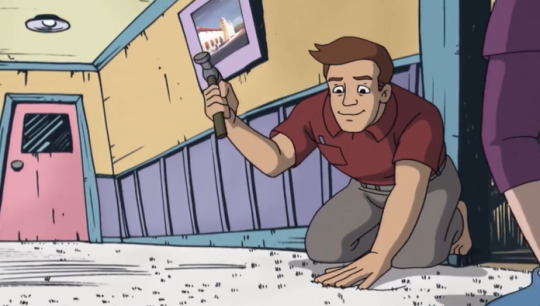
(quick note: yes, the show uses real photos to put in picture frames in the backgrounds and it’s real weird and never addressed)
Jack, Dawn’s dad.
Jack is a sheep shearer, just like in the books, and he’s a big easy-going dope that is hard not to love. Look at him hammer in this carpet. A true champ.
Out of the three adults in the family, he seems to be the one that nearly dies the most, with The Appleman going out of his way to specifically target Jack in some episodes. If you know Appleman’s backstory, this reads as absolutely petty spite and I love every minute of it.
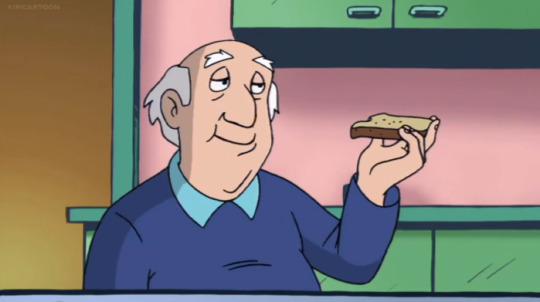
Gramps, Dawn’s grandfather and Jack’s dad.
He’s an aging WWII veteran (one that has killed people in combat no less) who radiates constant Boomer vibes and, unlike Eileen and Jack, he actually sees some of the crazy shit that happens and will sometimes sense when something is infected with virus when the other two adults can’t.
In the books, he’s suffering pretty badly from dementia, but thankfully the cartoons drop that completely. I’m glad too, because I don’t have the confidence that they would’ve written it with enough sophistication to make it not seem ableist. Instead, he’s just your typical kooky cartoon grandfather.
He’s probably the adult that gets the most screentime because he will actually help Dawn and Rory out. Again, this ties into the books, where he was the main adult ally for the kids.
He says a lot of army-themed catchphrases. It’s a tad overplayed but it never really gets to a point where I would call it “annoying”. Also, instead of living in the house, he lives in a tiny granny flat on the property. Sometimes Rory spends the night there.
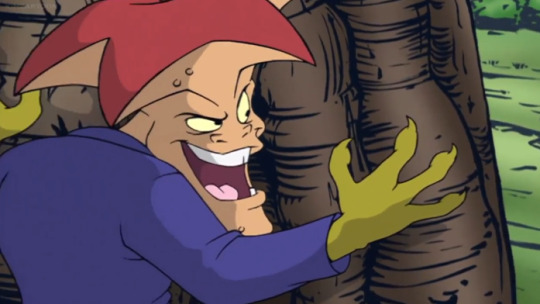
Last but not least, we have the star of the show, and the reason why the easiest way to find information of this show is to google “Wicked The Appleman”.
The Appleman, as explained, is the main villain of the story. Dressed in a very fancy suit complete with dress shoes and a nice blue tie, he lives in an old refinery full of rats, bats, and giant worms (called Slobberers), and he’s rocking a voice that can be best described as “Australian Mark Hamil” with an absolutely heavenly evil laugh. He has gross clawed hands, a rotten apple for a head, and likes making people miserable, because he’s basically the living puppet for a virus that feeds off of negative emotions. The main goal of each episode is to either defeat him or to stop the mess he’s made. Usually both.
Since all of his minions are non-sentient animals, a lot of his dialogue is him lurking behind something while he monologues to himself, sometimes turning it into a creepy little rhyme. He’s a pretty lonely guy, so him hanging out with this family can be seen as a very non-subtle cry for help.
The best episodes are the ones where he tries to lurk about in public with a very poor attempt at disguising his hideous features. Somehow it always works, you know, despite the fact that he has yellow eyes, the skin like a moldy apple, and no ears.
What Makes Wicked! Unique
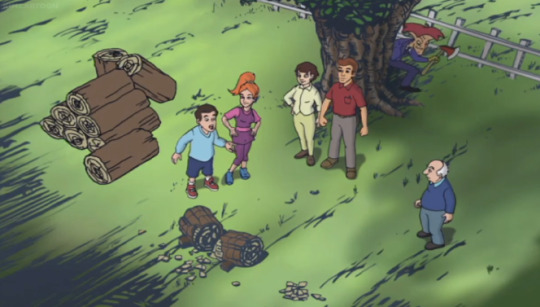
(no, The Appleman doesn’t actually use that axe)
The first thing this show does that most of the formulaic shows don’t do is that it does, in fact, have a beginning, a middle, and an end. That’s why this show was packaged into a full-length movie - you can glue scenes together and actually make a pretty decent narrative, even if the resulting movie definitely had a “glued together TV show episodes” feel ala some of the bad Disney sequels like Cinderella II and Atlantis II.
This show even has some plot-heavy episodes that dive into just why this whole Appleman situation is going on and why he seems to have it out for this one family in order to flesh out the characters more.
Because that’s a thing that this show does. The Appleman is a cartoon-y villain who cackles in his lab and constantly invents new strains of viruses that can mutate things like animals and household appliances, but he doesn’t do it to take over the city or to “destroy the world”. He does it purely to inconvenience this one Australian family, who he stalks pretty regularly. This is a thing that comes from the books and honestly, it’s a thing that elevates Appleman from “ugly-looking cartoon villain” to “pretty damn creepy, if also still cartoony in execution”.
Sure, a lot of cartoon villains target the main protagonist in their evil schemes, but this one is definitely more personal.
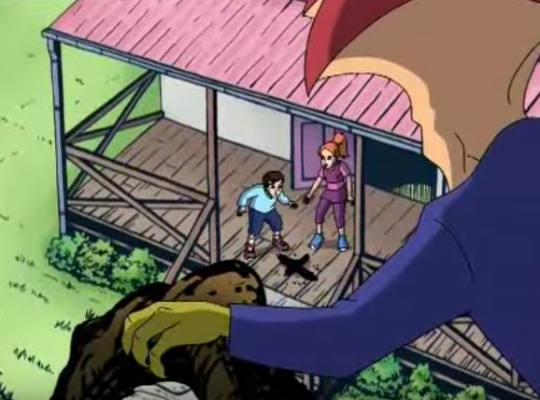
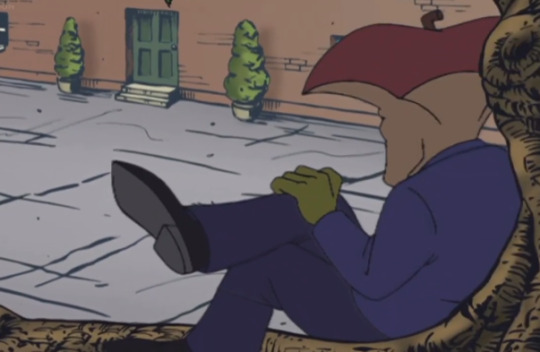
He regularly follows Rory and Dawn to school and, when the family goes on a camping trip, he comes too. If Rory decides he’s going to hang out in the wrecker’s yard, The Appleman will be cackling and hiding behind totaled vehicles. If Gramps takes the kids out to the bay to go fishing, The Appleman will pull an ice cream truck out of his garage and follow them there. That’s how the main conflict is really set up.
I think if a scarier cartoon tried, they’d make him out to be this grotesque stalker, but instead, since this show is kinda goofy in execution, he’s like the shittiest cryptid in the world, constantly crouching behind trash cans and on top of rooftops while constantly cackling about how clever he is and how, miraculously, no one notices anything’s amiss.
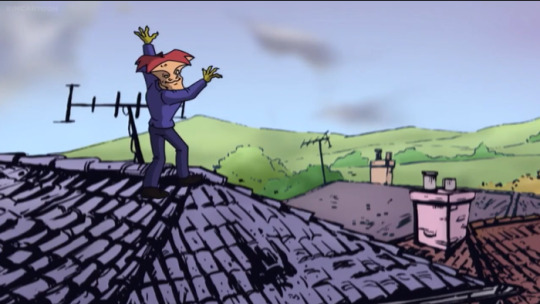
This alone would make this villain interesting, but then they set up something about this show at the beginning if you watch the intro and the first episode and put two and two together.
Right from the start, the opening shows that The Appleman was once human by depicting his transformation by the virus. They don’t even try and pretend that he’s some demon or some sort of supernatural monster - he’s specifically a blue collar worker who had a nasty run-in with fate and mutated into this hideous apple-headed creature that now has to hide out in an abandoned refinery. You see why he’s dressed like that - he’s still wearing his work uniform.
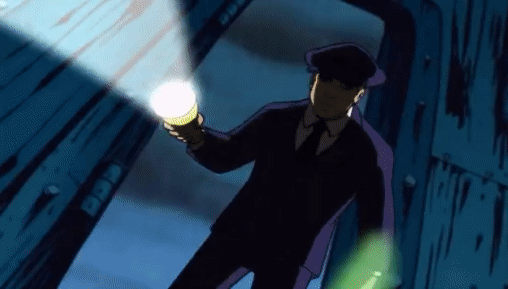
Right after you watch that intro, the first episode of the show has Rory receiving a mysterious package from his father on the day of his mother’s wedding. It’s the first time that Rory and his mom Eileen have heard from their dad after he mysteriously vanished years ago.
What’s inside? An apple-headed doll, which contains the first virus-infected monsters, The Slobberers.
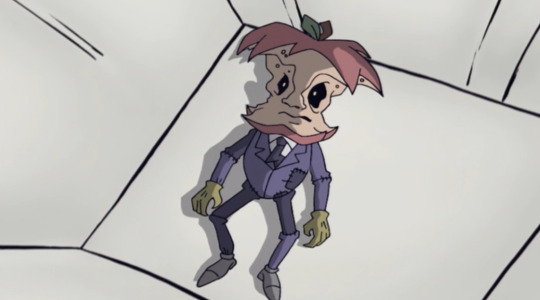
When The Appleman makes his first dramatic appearance, he never says Dawn’s name, but he does know Rory’s name.
And, in case you didn’t pick up the hints from the first episode, the fourth episode really drives it home without spelling it out. Then the last episode of the series decides to say it out loud.

That’s right. Rory’s father, the man who mysteriously vanished from Eileen and Rory’s lives, is still an important part of the cartoon’s storyline, but instead of being the man who appears in the last book that knows how to cure the virus while also being the first victim of the virus, he’s the main antagonist.
The Appleman is Rory’s father.
And honestly, because of this little plot point, this show becomes a much richer experience once you look at the unhinged appleman who keeps unleashing horror on these kids and realize that he’s a divorced dad who constantly keeps tabs on his ex-wife's unstable dysfunctional family in order to make them more pissed at each other because that feeds the virus that mutated him.
This is a very cool concept. This is where Wicked! shines when, for all intents and purposes, it is otherwise a pretty average turn-of-the-century Australian cartoon that can be best described as “it’s okay, I guess” in terms of quality.
Because that’s really the rating I can give this show. It’s Okay.
It’s a very solid Okay, but I think any adjective more powerful than “Okay” is really pushing it. It’s not Great, it’s not Amazing. It’s Okay. Alright. Kinda Good.
But man, is it a wild ride.
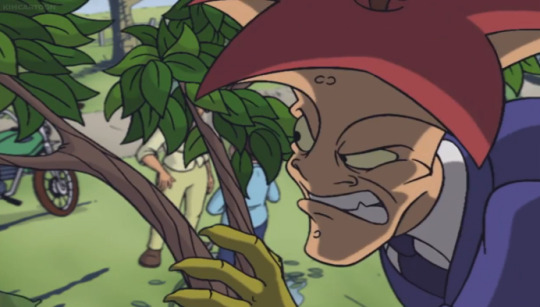
Next time, I’m going to start discussing the actual episodes as well as this show’s pros and cons. Dividing this up into multiple parts partly because I feel like these things are more easily digested in smaller chunks and partly because I’m pretty sure tumblr now has a size limit on posts soooo...yeah.
Follow this handy link for Part 2 - The Actual Review!
18 notes
·
View notes
Text
LG G1 OLED TV review: Tough to improve on near-perfection
New Post has been published on https://appradab.com/lg-g1-oled-tv-review-tough-to-improve-on-near-perfection/
LG G1 OLED TV review: Tough to improve on near-perfection

For years OLED TVs have delivered the best image quality available with display technology that has remained largely unchanged, but LG promised something even better for 2021. The G1 has an all-new panel not available on any other TV LG sells. The company calls it Evo and says it achieves higher brightness and improved color. My verdict? Yes, it’s slightly better than before but even in a side-by-side comparison, it was difficult to tell the difference.
Like
Best picture quality we’ve ever tested
Slightly brighter than previous models
Beautiful slim design perfect for wall-mounting
Don’t Like
Expensive
Image quality improvements over cheaper OLED TVs are minor
I set up the G1 next to the CX, the best TV I reviewed in 2020, measured both and watched a variety of TV shows, movies and games. The G1 was indeed a bit brighter than the CX but color was nearly identical, as were other aspects of picture quality like video processing and uniformity. Both looked spectacular, however, and in most material I really couldn’t say one looked better than the other.




Now playing: Watch this: LG G1 TV review: Can OLED picture quality get even better?
8:56
The main advantage the G1 has over the CX and pretty much every other OLED TV is its unique design. This TV is made to be wall-mounted — quite literally; it doesn’t even come with a stand! If you want to put it on a piece of furniture, as shown in the images in this review, you’ll have to pay $100 extra for LG’s little side legs. And that would be a shame, because something this thin should really be on a wall.
New for 2021 LG has improved its already best-in-class gaming features by adding picture modes especially for games, as well as a convenient menu that shows all gaming info and adjustments in one place. There’s a new remote and a new smart TV homepage, too. The more affordable C1 shares those features with the G1, however.
At this point, the G1 is the best TV I’ve ever tested — by a nose. I have yet to review its competitor from Sony, the A90J, which also promises a brighter panel, or any other high-end TVs like Samsung’s Neo QLED models, so that title might not last. But for people who don’t have money to burn, the extra picture quality of the G1 probably isn’t worth the extra money over mainstream OLED models like the CX or C1.
Get to know the LG G1 series
It comes in three sizes and costs a bundle: 55-inch ($2,200), 65-inch ($3,000) and 77-inch ($4,500).
It differs from the less expensive C1 series by offering fewer sizes (the C1 has 48-inch and 82-inch options too), that Evo panel and the slimmer, wall-mount-centric Gallery design. The C1 also lacks a far-field mic for hands-free voice and a Next-Gen TV tuner, both relatively minor extras included on the G1.
OLED display technology is fundamentally different from the LED LCD technology used in the vast majority of today’s TVs, including Samsung and TCL’s QLED models.
The best LCD TVs I’ve reviewed so far scored a 9 in image quality, while OLEDs TVs like the G1 have scored a 10. High-end LCDs (especially with HDR) are brighter than OLEDs, but the picture quality on OLED TVs, including that of this G1, is superior overall.
All OLED TVs are more subject to both temporary and permanent image retention, aka burn-in, than LCD TVs. We at CNET don’t consider burn-in a reason for most people to avoid buying an OLED TV, however. Check out our guide to OLED burn-in for more.
Throw it at the wall
A TV doesn’t get any more minimalist than this. Like many sets these days the G1 is pretty much all picture when seen from the front, but it’s the side view that sets it apart. It measures just 0.8 inches deep and is designed for nearly flush wall-mounting. And as I mentioned at the top, it doesn’t even come with a tabletop stand: If you want a stand mount, it will cost $100 extra.

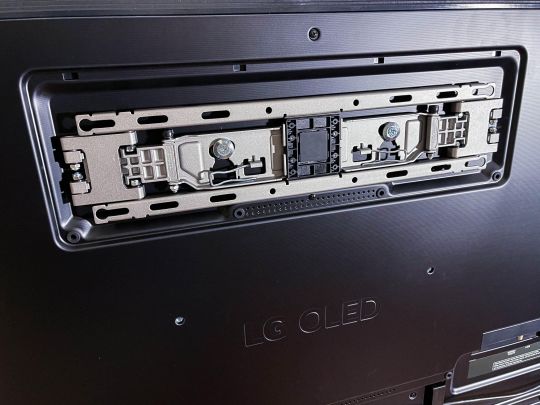
The G1 comes with a wall-mount bracket inset into a cavity on the back for a practically flush mount.
Sarah Tew/CNET




Here’s what it looks like flush against the wall.
Sarah Tew/CNET
This TV’s design is wasted if you don’t wall-mount it. LG includes a custom bracket in the box and instructions that make it easy to slap up yourself if you’re at all handy — although I’m guessing most people in this price bracket will hire somebody to do the job. Thanks to an inset on the back of the TV the wall mount doesn’t add any extra depth, allowing the G1 to hug the wall and present a very slim profile. Channels are built into the TV’s back to run cables through, for a cleaner installation behind the TV. LG recommends using molding to hide cables on the wall itself. Note: I didn’t mount it myself in my test basement, but I’ve mounted plenty of TVs before and this one seems like it would be a simple job.

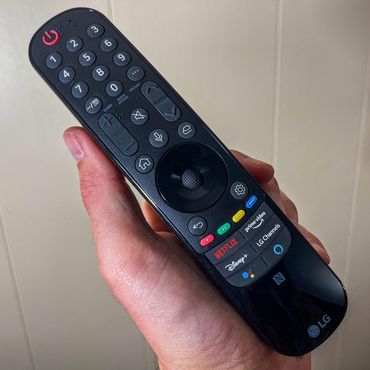


LG’s redesigned remote still has lots of buttons and motion control.
Sarah Tew/CNET
LG revamped the remote a bit. It kept my favorite features, namely the scroll wheel and motion-tracking, while slimming it down slightly. The biggest difference is the shortcut keys at the bottom: four for streaming services and two more for the built-in voice assistants, Google Assistant and Amazon Alexa. The former wasn’t yet available on my G1 review sample, but LG says it will be soon.
The G1 is also equipped with a far-field mic (not available on the C1) so you can simply say the wake word to get the TV to respond, no remote required. It responded just like I’d expect from a smart speaker to my “Alexa” commands.
Based on my experience with the CX, both Google and Alexa can do all the usual assistant stuff, including control smart home devices, answer questions and respond via a voice coming out of the TV’s speakers (yep, both voices). Basics like “What’s the weather?” works as you’d expect, complete with onscreen feedback. The G1 also works with Apple’s AirPlay 2 system, just like many other TVs, allowing my iPhone to share photos and video to the screen from the Photos app and mirror my Mac and phone screens.
LG’s webOS menu system got a facelift for 2021 — and I’m not a fan. Gone is the small, unobtrusive overlay at the bottom of the screen that lets you keep tabs on what you’re watching. Instead there’s a full-screen homepage, similar to Roku, Fire TV and Android TV. But it has fewer apps and more, well, junk. The top two-thirds of the screen are devoted to the weather, setup tips, a search window and a Trending Now section with a random collection of TV shows and movies. Below that is an app row and, further down, sections devoted to inputs and particular streaming apps. In general it feels like a hodgepodge with too much going on, and most systems are simpler and easier to grasp.

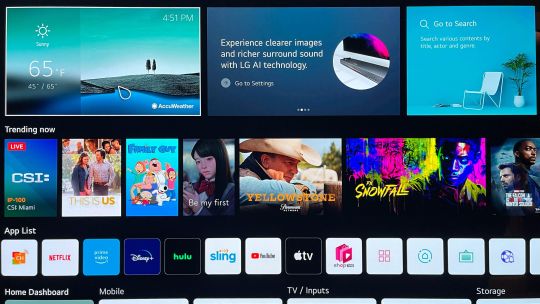


The new homepage takes up the entire screen.
Sarah Tew/CNET
Features galore, state-of-the-art connectivity
LG says its Evo panel, available only on the G1 this year, uses a “new luminous element” for more precise lighting. The construction of the OLED pixel itself is different, with new materials for red and blue and a new green layer, all of which have narrower wavelengths compared to the pixels used on other OLED TVs.
Key TV features
Display technology OLED LED backlight N/A Resolution 4K HDR compatible HDR10 and Dolby Vision Smart TV Web OS Remote Motion
Otherwise the G1 has the same image quality features as the C1, starting with the new Gen 4 a9 processing chip that adds scene detection and upgraded object enhancement over last year’s version. Both the G1 and C1 also have a 120Hz refresh rate. The entry-level A1 OLEDs, meanwhile, have a more basic a7 processor and 60Hz refresh rate.
Just like last year, LG’s OLED TVs’ picture settings include a Filmmaker Mode. As promised, it turns off the soap opera effect for film-based content (yay) but so do many other modes in the G1. While plenty accurate, Filmmaker Mode is also relatively dim so I ended up using Cinema and ISF Bright for most critical viewing.

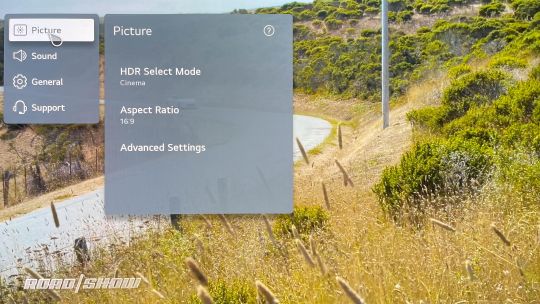


Sarah Tew/CNET
All of LG’s recent OLED models (except the A1) include the latest version of the HDMI standard: 2.1. That means their HDMI ports can handle 4K at 120 frames per second and variable refresh rate (VRR, including NVIDIA G-sync and AMD FreeSync), as well as enhanced audio return channel (eARC) and automatic low latency mode (ALLM, or auto game mode). That means they can take advantage of the latest graphics features available on PlayStation 5 and Xbox Series X and S. New for 2021 is a Game Optimizer mode that puts all of the TVs’ gaming-related settings in one place; see below for details.
The selection of connections is otherwise top-notch, though it no longer supports analog component video. There’s also a dedicated headphone or analog audio output and another for IR blasters, which could ease some installations.
Four HDMI inputs with HDMI 2.1, HDCP 2.2
Three USB 2.0 ports
Optical digital audio output
Analog audio 3.5mm headphone output
RF (antenna) input
RS-232 port (minijack, for service only)
IR blaster port (minijack)
Ethernet (LAN) port




Sarah Tew/CNET
Picture quality comparisons
With its slightly better picture and a couple of other minor improvements the G1 beat the CX, my previous picture quality champ, in side-by-side comparisons. According to my measurements and eyeballs, however, the brightness difference was minor enough to be invisible at times, and just about every other aspect of picture quality was virtually identical. Both TVs looked a tad better than the less expensive Vizio OLED.
Dim lighting: The G1 performed like a champ with the lights down low — and so did the other two OLED TVs in my comparison. I checked out The Hobbit, An Unexpected Journey on standard Blu-ray, and they all appeared more or less uniformly excellent: perfect black levels in the letterbox bars and deep shadows of Bilbo’s living room during the dark Dwarven chant (36:58) and plenty of details in the shadows and clothing of Thorin and company. I couldn’t see any real advantage of the G1 with this kind of theatrical situation in standard (non-HDR) material.
Bright lighting: For a TV billed by LG as an improvement in brightness, the G1’s measurements didn’t really stand out. Yes, it did measure brighter than last year’s CX by 129 nits in the most accurate HDR modes, but that’s not a huge leap and proved tough to discern in most program material. I was also surprised that the C9 I reviewed from 2019 was brighter at maximum light output and basically the same in its accurate mode. As usual, any high-end LCD is much brighter.
Light output in nits
TV Brightest (SDR) Accurate color (SDR) Brightest (HDR) Accurate color (HDR) TCL 65R635 1,114 792 1,292 1,102 Sony XBR-65X900H 841 673 989 795 Vizio P65Q9-H1 768 629 1,305 1,084 Samsung QN65Q80T 664 503 1,243 672 LG OLED65G1 377 334 769 763 LG OLED65CX 377 290 690 634 LG OLED65C9 (2019) 451 339 851 762
I asked LG’s representatives whether my particular review sample’s brightness was typical of other G1’s and they said it was. As always, different sizes and samples can produce variations.
LG OLEDs of recent vintage have a setting called Peak Brightness that boosts the light output for SDR sources in Cinema and Expert modes. The idea is to increase contrast for brighter viewing environments while maintaining the superior color accuracy of those modes. As with most TVs, the brightest mode for HDR and SDR (Vivid on the G1) is horribly inaccurate. For the accurate color columns above on the G1, I used ISF Expert Bright (Peak Brightness: High) for SDR and Cinema mode for HDR — I recommend G1 owners do the same to get good color in bright rooms.
All recent OLED sets are still plenty bright enough for just about any viewing environment. Yes, they do get quite a bit dimmer than LCDs when showing full-screen white — a hockey game, for example — but even in those situations they’re hardly dim. The G1’s screen preserved black levels and reduced reflections very well.
Color accuracy: LG claims better color with the new Evo panel but according to my measurements and eyeballs, it’s tough to spot any difference. Color on the CX was excellent and the G1 was basically the same. An LG rep told me that the G1’s white color could look more pure, like in a hockey match, but I didn’t see or measure any differences in full-field white/gray (ones that weren’t due to very small differences in grayscale after calibration, at least).
Watching The Hobbit was mostly the same story, although at times greens, like the grass and hillsides of the Shire (12:24), appeared a bit more greenish and less yellowish on the G1. It was a subtle difference at best, and again I didn’t see or measure any difference in green test patterns, but it could be due to the new panel. Maybe.
Color on the G1 was nonetheless extremely accurate both before and after calibration. The warm tones of Bag End’s interior and Bilbo’s skin were inviting and intimate, and outside his hobbit hole the green of the grass and trees in the golden hour sun, and the red and blue circular doorways on Bagshot Row, looked brilliant and natural. The same could be said for the other OLED TVs, however, and none delivered significantly better color than another.
Video processing: LG goes to great lengths to tout the improvement of its processing every year, but watching various material in the best picture settings the CX and G1 looked largely identical to me.
Motion handling on the G1 is excellent and a touch better than the CX. Under TruMotion, the new Cinematic Movement setting (the default for Cinema mode) served up 24-frame cadence with a very slight hint of smoothing, improving on last year’s too-smooth Cinema Clear setting while preserving 600 lines of motion resolution. 24p purists who want no smoothing at all will opt for the Off position (the default for Filmmaker mode) and suffer the low motion resolution, while tweakers will appreciate the fine granularity of the User De-Judder mode to dial in the right amount of smoothness; anything four or lower introduced some judder to my eye, conveying a sense of film rather than soap opera effect. De-Blur settings of five or higher deliver the full 600 lines of motion resolution.
User also opens up the OLED Motion Pro menu with three levels of black frame insertion that further improve motion resolution, with 800 lines in Low and a full 1200 in Med and High. The latter introduces flicker, unfortunately, and all three are a bit dimmer than Off, but if blur really bugs you then they’re worth experimenting with. One improvement over last year is that engaging OLED Motion Pro no longer totally crushes shadow detail — it’s a bit worse but still very good. Still, I’d choose to leave it off and sacrifice some motion resolution for maximum light output and shadow detail.
Uniformity: Like all OLEDs I’ve tested the G1 was exemplary in this area, with no significant brightness or color variations across the screen and nearly perfect image quality from off-angle. Compared to the CX I did see a bit more color shift toward magenta in extreme angles with full-field mid-bright and brighter test patterns, but it disappeared when I moved closer to on-axis and never affected the image from a normal viewing angle.

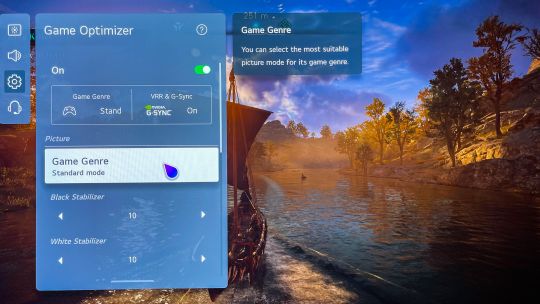


Sarah Tew/CNET
Gaming: The G1’s superb image quality carries over to games, and some of its biggest 2021 features upgrades are gaming-related. The new Game Optimizer is the name of both a picture mode and a full menu system. The latter offers all-new tweaks including four game genre modes: Standard, FPS mode (said to boost shadow detail), RPG mode (to boost contrast) and RTS mode (said to enhance mid-grayscale areas). There are also sliders labeled Black Stabilizer (for adjusting dark areas) and White Stabilizer (for bright areas), as well as the OLED Motion Pro setting described above (LG says it’s particularly useful for games) and the Reduce Blue light setting (said to be easier on the eyes).
I started my test in standard mode with settings at their defaults with Assassin’s Creed: Valhalla at 4K/60Hz and HDR running through my distribution amp so I could compare against the other TVs. Conducting a nighttime raid, the G1 looked most similar to the CX and the Vizio in its standard mode and all three TVs looked excellent, with the G1 delivering a touch better shadow detail already. Switching to FPS upped details even further but washed out the image a bit much for this cinematic game — although I can see it being useful in an actual FPS game if you want to reveal lurking enemies, or a very dark HDR game like Ghost of Tsushima. The RTS setting did boost midtones at the expense of some contrast, while RPG looked quite close to standard, if not as impactful to my eye. In any case it’s cool having these extra adjustment options, and I liked that they each get a dedicated menu.
Next I connected my Xbox Series X directly to the G1 to test advanced video features. VRR worked as expected, significantly reducing tearing in Assassin’s Creed: Valhalla, and I appreciated the prominent toggle and indicator in the Game Optimizer menu that assured me VRR was engaged. Another slider labeled Fine Tune Dark Areas is available to address the issue of VRR looking too dark. I headed deep into a crypt where VRR was crushing shadows a bit — cranking up that setting, as well as the Black Stabilizer, helped. The flipside is that doing so spoiled black levels and washed out the look of the game, so (as a card-carrying contrast fiend) I’d avoid using it unless it really hurts your gameplay.
I also tried 4K/120Hz on Gears 5 and Star Wars: Squadrons, but the extra smoothness and framerate were difficult to discern in most cases. I appreciate that some games, like Ori and the Will of the Wisps, showed a splash screen indicating that 120fps was active, but most did not. I looked for confirmation in LG’s display menu but, unfortunately, it doesn’t have any. Samsung’s new 2021 Game Bar, on the other hand, does indicate 120fps.




Sarah Tew/CNET
Buried within Game Optimizer is another setting labeled “Reduce input delay (input lag)” with two options, Standard and Boost. The former, which is the default for any game, serves up an excellent lag number similar to past LG OLED models: just 13.1ms for both 1080p and 4K HDR sources. Engaging Boost cuts lag even further, to just under 10ms for both. The catch is that Boost is only available for 60Hz sources, so you can’t use it with 120Hz games or VRR. And no, I don’t think many humans would notice the extra 3ms of lag.
HDR and 4K video: It’s with HDR that you’d expect the G1’s brightness advantage to be most visible, but watching the 4K Blu-ray version of The Hobbit, differences were again very slight. Highlights like the sky behind the elven king as he turns away from Thorin (7:59) or the window in Bilbo’s study (9:06) measured slightly brighter on the G1 than on the CX according to my light meter but without measuring it was tough to see the difference by eye, even when compared side by side. Highlights on the Vizio appeared visibly dimmer than either one, for less HDR pop, but the differences were much narrower between the two LGs.
Color was likewise pretty much equally spectacular on the LGs and a step behind on the Vizio, which looked a bit duller in Bilbo’s garden and the blue sky for example (13:25). Any color improvement afforded by the G1’s new panel tech over the CX was less visible with HDR than with SDR.
I also checked out some of the most revealing HDR content around: the montage of images from the Spears and Munsil 4K HDR benchmark. Again the G1 was superb and better by a slight margin than the CX, but the G1 failed to really distance itself. Most scenes looked very similar between all three, from the crashing waves to the sunsets to the flowers to the objects on black backgrounds, and in most cases when I saw a difference it was the Vizio lagging a bit behind the other two. Spot measurements revealed mildly brighter highlights on the G1 but I couldn’t tell the difference without measuring.
The benchmark also has a 4,000 nit montage to test content mastered at that level and; again, both LGs looked very similar. They outclassed the Vizio, which looked somewhat flat in some scenes in comparison.
Picture settings, HDR notes and charts
CNET is no longer publishing advanced picture settings for any TVs we review. Instead, we’ll give more general recommendations to get the best picture without listing the detailed white balance or color management system (CMS) settings we may have used to calibrate the TV. As always, the settings provided are a guidepost, and if you want the most accurate picture you should get a professional calibration.
Before my calibration for this review the Cinema and preset was the most accurate, excellent in terms of grayscale and gamma with just a slight reddish cast (but still within my error target of delta 3). Since I now target a 2.2 gamma for my reviews dark rooms it was closer than ISF Expert Dark or the new Filmmaker modes, which both target gamma 2.4/BT 1886. ISF Bright was basically identical to Cinema, but I reserved that for brighter rooms.
For my calibration I tweaked the two-point grayscale to remove the red cast, reduced light output to my target of 137 nits and increased brightness two pips to help with shadow detail (while still keeping perfect black levels), but otherwise I left well enough alone. The grayscale and color were already so accurate on my LG-provided review sample that I didn’t need to touch the multipoint system or the color management system.
SDR dark room settings:
Picture menu:
Select Mode: Cinema (User)
Aspect Ratio Settings: 16:9 (Just Scan: On)
Additional Settings menu:
Brightness submenu:
OLED Pixel Brightness: 48
Contrast: 85
Screen Brightness: 52
Auto Dynamic Contrast: Off
Peak Brightness: Off
Gamma (Adjust Brightness): 2.2
Black Level: Auto
Motion Eye Care: Off
Color submenu:
Color Depth: 50
Tint: 0
Color Gamut: Auto Detect
Fine Tune menu:
Color Upgrade: Off (no other adjustments)
White Balance menu:
Color Temperature: Warm 49 (no other adjustments)
Clarity submenu:
Sharpness: 0
Color: 50
Tint: 0
Super Resolution: Off
Noise Reduction, MPEG Noise Reduction: Off [for low-quality sources, some users may prefer to enable noise reduction]
Smooth gradation: Off [for low-quality sources, some users may prefer to enable]
Cinema Screen: On [may be grayed out depending on source]
TruMotion: Cinematic Movement
Reduce Blue Light: Off
SDR bright room setting [all default except for below]:
Picture Mode Settings: ISF Bright Room
Brightness menu:
OLED light: 100
Peak Brightness: High
HDR Notes: HDR Cinema and Filmmaker mode were very similar, following the electro-optical transfer function — how the TV converts data to a specific brightness — quite closely and better than Cinema Home, but Cinema was about 70 nits brighter so it’s my favorite of the three. Game Optimizer is best for gaming thanks to its processing but quite blue; for the best color accuracy for gaming you should adjust the color temperature control (Color > White Balance > Color temperatureW45).
Color checker was slightly more accurate than on the CX from last year but not great, and HDR Color Checker was worse. As usual with OLED the set covered P3 HDR gamut very well. The G1 measured brighter than the CX or the B9 from 2019, but the C9 from 2019 actually measured brighter in its least accurate and basically the same in its most-accurate settings. Once again the TV automatically detected and engaged the “HDMI Ultra HD Deep Color” setting designed for HDR sources.
TV software/firmware version tested: 3.10.29
Geek box
Test Result Score Black luminance (0%) 0.000 Good Peak white luminance (SDR) 377 Average Avg. gamma (10-100%) 2.18 Good Avg. grayscale error (10-100%) 0.40 Good Dark gray error (30%) 0.42 Good Bright gray error (80%) 0.33 Good Avg. color checker error 0.80 Good Avg. saturation sweeps error 0.79 Good Avg. color error 0.94 Good Red error 2.22 Good Green error 0.64 Good Blue error 0.46 Good Cyan error 0.97 Good Magenta error 0.98 Good Yellow error 0.36 Good 1080p/24 Cadence (IAL) Pass Good Motion resolution (max) 1200 Good Motion resolution (dejudder off) 600 Average Input lag (Game mode) 13.10 Good HDR10 Black luminance (0%) 0.000 Good Peak white luminance (10% win) 769 Average Gamut % UHDA/P3 (CIE 1976) 98.91 Good ColorMatch HDR error 5.25 Poor Avg. color checker error 3.29 Average Input lag (Game mode, 4K HDR) 13.10 Good
LG G1 OLED TV CNET review c… by David Katzmaier
Portrait Displays Calman calibration software was used in this review.
How We Test TVs
0 notes
Text
The best retro gaming consoles of all time
Modern video games and devices provide a storytelling experience that rivals the blockbuster Hollywood movies, but also requires a heavy commitment to your playing time.
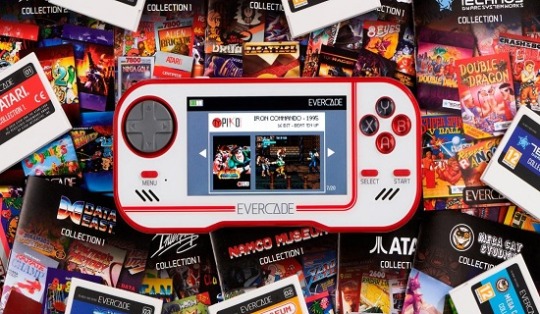
Retro gaming consoles
Sometimes you just want to jump into the action, and your favorite 8 and 16-bit games from last year are perfect for that. Retro games are more popular than ever, and finding the perfect old gaming gear can be a daunting task. So we did the work for you.
Whether you're a kid of the 1980s playing classic titles for decades and owning a mountain of old cartridges (and a hard drive full of ROM) or a teen curious to find out why so many people love the Super Nintendo and Sega Genesis, this guide will help you find the best way. To immerse yourself in old games.
Purchase forecasts for the remainder of 2020: While manufacturing and shipping delays that slowed deployments of new devices in 2020 continue into 2021, long-awaited older device releases like Analogue's Pocket and Panic's Playdate are on the way. Still in months.
Small businesses, many of which are located in China, are always releasing cool old laptops, including the new Anbernic-inspired RG280V. One of the hottest elements for this Christmas is also a Nintendo renaissance and watch, but availability will be very limited and dedicated to Super Mario Bros fans.
The Best Portable Console for Experienced Retro Gamers
Anbernic RG350P
Just a few years ago, portable emulators made by former Chinese gaming fans were good, but not very good, and lacked the quality you'll find with big-company devices. This is no longer the case. The Annbernic RG350P looks solid like the Nintendo Switch, but instead of cartridges, it plays games using ROMs stored on microSD cards, for consoles such as various Game Boys, NES, SNES, the Sega system.
Master, the original Sony PlayStation Genesis, and even older PCs. Like the Commodore 64. At around $ 88, it is also priced right for its capabilities but just be prepared for some forum research and tutorials when it comes to installing new emulators or making new ones. software updates, as the RG350P is designed for those more tech-savvy.
The RK2020
The price of the RK2020 is the same as that of the RG350P, it features a screen with remarkable accuracy, provides decent control, and a faster processor that allows it to play a large number of games from more powerful 3D consoles, including the N64. And Sega Dreamcast. The single analog stick makes playing PS1 games difficult (but not impossible), although the level of technical skill required to simply copy ROM files to its Linux formatted memory card makes the RK2020 much more difficult to operate.
Instead of giving players a classic version of the Game Boy, Nintendo celebrated Mario's 35th birthday this year with the relaunch of its old school console Game & Watch that defined handheld games in the 1980s. New Game & Watch: Super Mario Bros. Includes the original NES version of Super Mario Bros.
Its sequel, plus a classic G&W game called Ball, test the magic of Mario and Luigi. However, it is only available in limited quantities and $ 50 is very expensive for only three old games. Alternatively, consider the new Anbernic 280V retro. It puts electronic components for the RG350P in a compact, pocket-friendly device.
The two RG350P analog controllers are sacrificed in the process, however, which means that the RG280V is more suitable for playing games from the 16-bit era onwards. At roughly $ 85, it's more expensive than Nintendo's new Game & Watch, but it can also play thousands of old games, not just three.
The Best Portable Console for Casual Retro Gamers
Evercade
Unlike the RG350P and RK2020, Evercade does not require users to provide their own games. Its creators worked on licensing official games from the original publishers to create a thematic cartridge bundle each containing multiple games.
There are over 120 games available for Evercade right now, and more are on the way, and for $ 100 you can turn off the handheld console itself and three game-filled vehicles to get you started. This approach means that Evercade doesn't rely on emulators, so every game works just like in the original system, with no slowdowns or audio out-of-sync issues.
Analogue Pocket
Until the Analogue Pocket officially arrives in May 2021, there aren't many portable console options that could run the original game carts if you still had your original kit on hand. But the $ 80 My Arcade Retro Champ can power the original 8-bit NES and Famicom game cartridges if you're okay with a portable console that's too big for a pocket.
My Arcade has also revealed a follow-up, Super Retro Champ at CES 2020 that can power the original Super Nintendo and Sega Genesis cartridges but is currently another victim of manufacturing delays linked to the pandemic.
Super Impulse's Micro Arcade
If the size is an issue, Super Impulse's Micro Arcade line puts classic games like Pac-Man, Tetris, Dig Dug, Galaga, Oregon Trail, and Qbert into handheld devices the size of a credit card with the price tag. ranges from $ 20 to $ 25 depending on how many games are included in each one. Designed by the same engineer who created open-source Arduboy:
The credit card-sized Game Boy lets anyone program and creates their own games. With a black-and-white OLED display, Arduboy games are as simple as old games can get, and while you won't find any A-list titles available for credit card-sized mobile devices (which whether the clone of Tetris or Space Invaders), all games are available.
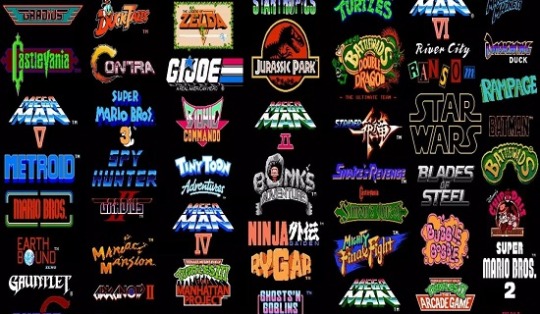
Retro gaming
Currently completely free. You can get a version of Arduboy that lets you download one game at a time for $ 29, or wait until fall 2020 to get the new Arduboy FX at $ 49, which includes additional memory that can hold around 200 games at a time. times.
Many retro pocket players believe the genre has been mastered with the original Game Boy, Game Boy Color, and various iterations of the Game Boy Advance. If you prefer to stick with what you know, companies like Retro Modding can create a custom version of the popular Nintendo laptop for you using a mix of legacy hardware (original motherboards) and the latest parts including rechargeable batteries, backlit LCD screens, and more powerful speakers. Colorful buttons and bags that match the originals or feature more elaborate designs.
Custom versions can set you back up to $ 500 if you choose to upgrade every last component and it often takes a few weeks to build, but if you're sad the original Game Boys won't work anymore, replacing the rebuild is the best thing you do.
Alternatively, with more than 55 million consoles sold so far, there's a good chance you'll have a Nintendo Switch or Switch Lite at home. The cartridge slot won't accept older Game Boy games - a feature Nintendo has included in their latest mobile devices for a while - but if you're paying for the Nintendo Switch Online service ($ 3 a month or $ 20 a month). A), you might not realize it.
Two free apps you can download that gives you access to a library of over 60 classic NES and SNES games, with Nintendo being added to the library every few months. This makes playing the classic 8 and 16-bit Nintendo games very easy and the simulation is perfect, but access is only granted as long as you pay for the Switch online service.
The Best Console for Retro Gamers
Analogue Super Nt
In just a few years, Analogue has made a name for itself as the best possible solution for playing old original game cartridges on modern TVs. Instead of relying on software emulators that can be buggy with a performance that varies from game to game, Analogue's 16-bit Super Nt uses a custom FPGA chip that perfectly emulates Super Nintendo hardware. origin.
Every game works flawlessly and the console includes an HDMI connection and countless options to customize the look of games on a giant screen so you can get as close as possible to recreating your childhood gaming experience. At $ 180, the Super Nt doesn't come cheap, but the bigger problem is that Analogue only produces its material in small batches, so you might have to wait a bit before Super Nt is back in. stock.
Analogue Mega Sg
Everything we said about Analogue Super Nt applies to the Mega Sg, except instead of playing original Super Nintendo cartridges, the Mega Sg plays 16-bit Sega Genesis games, 8-bit Sega Master games, Game Gear (with the correct cartridge adapter), and even Sega games Perfectly CD, no lag, no frame drop and, most importantly, no audio sync issues that have plagued Sega emulators for years. Analogue currently has a Mega Sg in stock for $ 190, but don't drag your feet as the company's equipment often sells out quickly and takes time to restock.
Also Consider
Analog Mega Sg can run original cartridges from over a decade of Sega controllers, but Analog Super Nt is only SNES. If you also have a set of NES cartridges, you will need to look for the $ 500 Analogue Nt or the latest $ 500 Nt mini Analogue Nt which is currently out of stock Analogue itself but appears occasionally on eBay.
If you are looking for a cheaper solution and don't necessarily care about being able to power your old cartridges, Nintendo fans should definitely consider the $ 80 Super Nintendo Classic Edition that comes with 20 classic SNES 16-bit games and two. Matching consoles, or the classic $ 60 NES Edition that includes 30 8-bit games and a pair of old gamepads, but finding either might be a challenge now because Nintendo no longer produces the classic releases.
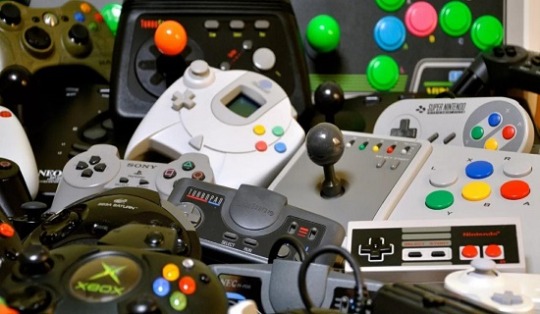
Retro gaming
However, Sega fans should have an easier time finding the $ 80 Sega Genesis Mini, which includes an impressive list of 42 built-in 16-bit games running from the polished Genesis emulator, while native PS1 fans can also grab the thumbnail. PlayStation Classic in one game, for $ 100, includes 20 games and a pair of consoles - although you don't get the enhanced DualShock option with an analog joystick side by side.
It's not hard to find an online tutorial on how to turn a Raspberry Pi into an old simulation game box. We made one with a Raspberry Pi 3, and the new Raspberry Pi 4 is a more powerful solution, and a good deal starting at just $ 35. If the DIY approach sounds too intimidating, there are some pre-built Raspberry Pi based controllers as well.
Allcade Itty Bitty smartphones look like regular NES, SNES, and N64 cartridges, but they're standalone controllers with USB power and HDMI connections hidden inside. 8-bit Allcade at $ 149 and 16-bit Allcade at $ 169 and $ 199 for 64-bit Allcade, each of which comes with a matching legacy controller and the ability to easily mount ROMs using a USB drive.
The best retro gaming consoles of all time Gaming via exercisesfatburnig.blogspot.com https://ift.tt/354fgnW
0 notes
Text
Zwia Reviews: Spider-Man Homecoming a.k.a. Oh Thank God
SPOILER FREE until I say Spoiler Alert
You know what I cannot stand? People on my news feed complaining about “ANOTHER Spider-Man movie.” “We’ve already had five Spider-Man movies. Why do we need ANOTHER???” You want to know why? You REALLY want to know why??? Because Spider-Man is THE Marvel hero, and frankly he has not been done justice in his own movie yet. You think Iron Man is awesome? You think Captain America is cool? Before the MCU NO ONE gave a damn about any of these characters. These were the character Marvel COULDN’T even sell the rights to when they needed the money in the 90’s. But Spider-Man, he’s Marvel’s best. He’s their big gun (popularity and story-wise. Power level he… he’s pretty outclassed) And this movie is important because he… well… he finally came home and showed just what a company that knows what they are doing can do with a GOOD character. That is not to say the Sam Raimi Spider-Man movies aren’t amazing, because they are. (Well the first two) and that’s not to say the Amazing Spider-Man movies aren’t… uh… lets not talk about those rushed cash grabs. What I’m saying is, Tom Holland’s portrayal of Spider-Man is the best and most accurate portrayal of the character we have ever had, and it is about gosh darn time Marvel finally had an “A” List character in their Cinematic Universe. So, BEST SPIDER-MAN MOVIE EVER… right? …right? uh… Kinda??? Before I go further, let me make this clear. Go see this movie. It’s a great and entertaining time. If you know nothing about Spider-Man (shame on you) you’ll still enjoy the movie whether it be it’s strong humor, it’s action, it’s likable characters, its drama. There will be something for you. And if you DO know Spider-Man, you will enjoy all the references and clever nods. OMG so many references. Not even just talking about referring to all the MCU stuff. There is just… SO MUCH ELSE. But BEST SPIDER-MAN MOVIE EVER????? Well, Spider-Man 1 and 2… I think are better actual movies. They have very clear messages and structure. They are creatively done. They pushed boundaries for their time. They balance dramatic moments and humorous moments and action beats and are unafraid to take chances and go all out… and frankly, they are lightning in a bottle experiences. They are just really incredible movies. (Even if the acting is kinda… meh) So, objectively, I’d say Homecoming isn’t on paper a better movie. But it IS the best Spider-Man character piece we’ve ever gotten.
If you want me to tell you who Spider-Man as a character is, this is what I’d show you. It may lack some of his more depressing struggles and turmoil… but everything else, is just pure Spider-Man. If anything, Homecoming doesn’t really feel like a movie. It’s more of a really long TV episode. It’s not some Epic Spider-Man set piece. It’s more of a glimpse at one of his small adventures, which works out really well. So lets talk about it. The story follows Peter after Civil War when he is struggling to impress Tony Stark and prove he’s superhero material. Most of his actions reflect this one track mindset and basically he gets himself into trouble because of it. It isn’t really the whole “Great Power/Great Responsibility” motivation that we’re used to, but it does the trick and pretty accurately shows Peter’s struggle to balance the real world with his super heroing, so I dig it. Also real quick, love this one subtle moment in the gym early in the movie. Peter is doing sit ups like a champ, coach tells him he’s doing good work, and Peter subtly starts to look like he’s struggling. It’s quick and simple and easy to overlook, but I loved it. It’s a VERY Peter thing to do. God shit like this make me really feel like these guys totally understand the character. And they KEPT doing stuff like this. Just damn. Stark himself is barely in the movie, but he’s pretty great when he is. This of course should be no surprise. Downey Jr. was pretty much born for this role.
Keaton’s Vulture has very clear motivation and is pretty darn interesting because of it. He basically plays up the current climate of people against the 1% that’s hitting the nation… and it’s just great. I have small issues with some changes they’ve done with his character, but overall its a great take and I’m happy they chose to delve more into his character than setting up Peter… a story we already know way too much of. And pretty much everyone else ever has their own little moments to shine. Everyone is pretty well-defined, you understand who every person is for the most part. It’s just all good things. The plot itself is pretty weak. Spider-Man wants to prove himself, keeps hunting down these arms dealer guys, keeps screwing things up. Rinse. Repeat. Enjoy the ride. But we’re not really in the movie for anything super major plot wise. It’s a character piece. And it delivers. And then it adds some fun action and jokes as well. Hell, if you just give me a montage of Spider-Man doing random acts of heroics around NYC I’d be happy. What? We get that in the first ten minutes??? HELL YEAH! And that’s really all I can say without getting into some Spoiler territory. It’s a special movie because it’s finally Spider-Man being the lovable screwup kid he’s supposed to be. BUT it doesn’t really do anything super crazy beyond that. Still, I’d say you need to see it. NOW FOR SPOILERS where I get into the fun stuff. Firstly OMG some of the references. For starters, DAMAGE CONTROL. OMG. For those that don’t know Damage Control is a company in the Marvel Universe that basically go around cleaning up the messes from superhero fights. They had their own comic and everything and it’s hilarious. I have been waiting for Damage Control to be name dropped for SO DAMN LONG and I am pumped that they went all out with it. Next, Donald Glover as Prowler… mentioning his nephew??? Uh… you mean Miles Morales???? Damn right that’s what they meant. That’s amazing. (No this reboot should not have been Miles. YES we all want a Miles movie, but not yet. Let Peter have his time. Half of Miles’s stories are all about him trying to step in Peter’s boots anyway. Y’all gotta build up to that people.) Okay, have I given enough space before I talk about the REALLY big stuff yet? Good. FUCKING VULTURE father reveal thing. You seriously gonna do that movie? Vulture’s kid is Peter’s friend??? Seriously??? You’re gonna pull a damn Green Goblin here??? You literally gonna steal almost beat for beat the Thanksgiving meal scene from Spider-Man 1???? Fine. You did it well. But here’s my problem. What happens when we bring Green Goblin into the MCU? You just gonna do the same thing over again??? Or is Vulture gonna be the new Goblin now…? Just… Damnit. I don’t hate it and I appreciate that you made a shocking moment that totally fits the themes of Spider-Man balancing his responsibilities over his personal desires. And I LOVE that Peter didn’t even flinch with his decision. He just ran off and was like, nope. This is what I gotta do. But DAMN. Uh… okay, I probably have more to say… uhh… Iron Spider reference, neat. Captain America stuff was amazing. Fuck yeah Scorpion. OH, the building falling on Peter and he struggling to get up? Literally one of the MOST FAMOUS SPIDER-MAN MOMENTS EVER. I don’t think it did the moment particular justice, but I do think it was done well enough and it was certainly awesome to see it done on the big screen.
Finally, the final battle… eh, kinda anticlimactic. The fight on the plane was cool, but once they hit the beach… Vulture just punches him a couple times, gets distracted, and blows himself up??? Really???? Oh, and little issues: 1. How did the boat get cut PERFECTLY in half? 2. If Peter knocked the wings off the plane to create a vacuum… how did Vulture get back in his wings to fight Peter outside the plane? Meh whatever, GO SEE THE MOVIE! OR GO SEE THE MOVIE AGAIN!!!! Buy it on Bluray. Tell your friends to see it. I NEED MORE!!!!!!
2 notes
·
View notes
Text
Kamen Rider 45th Anniversary File: Dragon Knight

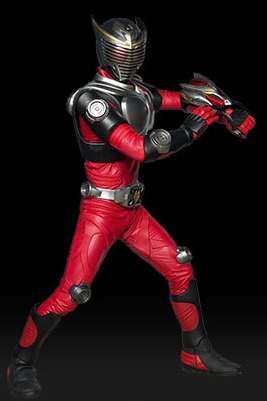
youtube
(Dive into the Mirror by defspiral, the original song opening created for the Japanese dub of a 2009 American adaptation to a 2002 Japanese show. Surreal just sayin’ that ain’t it?)
2009 in the USA
The Great Recession was “ending”....but its effects would linger on for several years.
Power Rangers was off the air at the end of RPM and a minor actor on the Mighty Morphin’ season was put on death row for murdering a couple with his wife as an accomplice.
Way back in 2006, producer Aki Komine was given permission by Toei to license a Kamen Rider Series for international distribution. Aki then chose SFX costume designer and filmmaker Steve Wang of live action Guyver movie duology fame, his brother Micheal Wang and a film crew to create a TV pilot of an adaptation to Kamen Rider Ryuki. This was later leaked online for KR fans around the world to see before being taken down in 2008. The general idea Aki, the Wang brothers and later a company called Adness Entertainment had was that Kamen Rider had potential to work in the US market as an action show.
Adness, unlike Saban, knew what Kamen Rider was and did not try to cheapen it to ride the coat tails of something that was a success in its own right or talk down to its audience. Kamen Rider just needed a minor bit of tweaking to account for the differences in cultures, but not so much that would make the source material unrecognizable or diminish its entertainment value. The target demographic after all was, like its Japan original, for pre-teens and teens but with enough of an entertainment factor for an adult audience to appreciate.
One thing was made clear by Aki to Toei: Don’t call it Masked Rider for international release, just call it Kamen Rider. This was done as Aki thought Masked Rider sounded “weird” and Toei wanting to distance themselves from Saban’s attempt to cash in on the beloved series.
Yes, Masked Rider is so awful to the fans of KR that even Japan, the land that created Kamen Rider, wants nothing to be associated with it. (Also, Masked Rider as a super hero name is/was trademarked by Marvel in the US).
The studio shopped around for networks and eventually got 4Kids to pick it up in late 2008. But, since the company was run by people who had an issue with anything that had what they deemed to be excessive violence in it, the Network later did whatever it could to sabotage the show’s airing schedule and tried to interfere with the production. This ultimately backfired on them in a karmic way after Dragon Knight ended, but more on that later.
Dragon Knight is notable for being the first and only Kamen Rider show to ever receive an Emmy award. The Daytime Emmy Award was for Outstanding Stunt Coordination, a relatively new category for the Emmys at the time. The award was given to the show’s coordinator Dorenda Moore, who aside from this series would later go on to work on Thor as the stunt double for Natalie Portman.
The award was well deserved, as the fight scenes are fantastic and truly reflect what the action of tokusatsu should be with stylized kung-fu martial arts. Helping this was the choice of 5 time martial arts champ Matt Mullins being chosen to play the secondary Rider Wing Knight.
The series also gets praise by the fandom for doing what no Kamen Rider show had ever dared to do at this point: Let a Female Rider actually...*gasp*.. LIVE?! And not only that, we got a female supporting cast character donning the persona of a Rider when the first is defeated and put in the Shadow Realm-y Place of Non-Deadness. While some call it a cop out, this is the one time the ineptness of 4Kids on the subject of death worked in its favor by the USA having 1 LIVING female Kamen Rider in the form of two heroines taking turns donning a single Rider belt trounce Toei Japan’s then count of 0 living female Riders. (Natsumi Hikari as Kiva-la wasn’t created yet). I refuse to see it in any other way than a blessing and in typical egotistic patriot fashion my countrymen are often stereotyped with, we more or less showed Japan female Riders can be in a show and kick butt. USA USA USA USA!
When Heisei Kamen Rider celebrated its 10 Riders anniversary, the show was brought over to Japan for broadcast and dubbed by many actors who were members of the cast of the Heisei part of the franchise. (Including Kenji Matsuda who played Wing Knight’s Japanese counterpart Kamen Rider Knight basically playing himself as an American XD). The show proved to be popular enough in Japan that the series got a sequel novel.
But sadly, America did not share the love, as changes in time slots and eventual removal of the show meant some fans didn’t get to witness it at all or only up to a certain point as the final episode only aired in Mexico and on 4Kids subpar online service, which went offline two years later and then died completely under the Saban Vortexx brand in 2014 along with the block.
To top it all off, this series is one of those “Never on DVD/Blu-Ray ever” shows in the USA, meaning torrents and streams or a cheap foreign legit or bootleg DVD copy are a fan’s only options. Which is ironic considering releasing the show consistently here would have prevented such a thing.
But KR fans and people who disliked 4Kids poor treatment of their favorite shows got the last laugh. The CW4Kids block died in 2009 and 4Kids went nearly kaput in 2012 as it filed for bankruptcy after a lawsuit and then went bankrupt again in 2016. The company’s main branch is struggling to stay afloat and only has a cash flow of $3.33 million which is in the negative based on reports a few years ago and only 16 employees are currently working there. (SO for 3.3 Million you could buy 4Licencing!) So, yeah, quite the fall form grace by the studio that once licensed and dubbed the Pokemon anime. (though given the One Piece rap and Dragon Knight’s treatment, I’d say it was well deserved karma.)
But enough talk, let’s Dive into the Mirror of Adaptation!
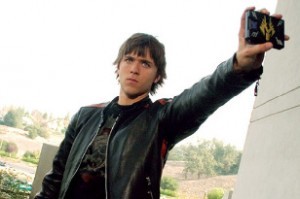
(Mr. Taylor Circa 2009)
Real Name: Kit Taylor (No relation to Jack Taylor, a person known for great parties. *MST3K joke*)
Kit Taylor is an orphaned teen who was framed a lot for being a thief and lived in a foster home. He went searching for his father after he turned 18 and came upon a strange looking card deck on a table in the old apartment he spent his earlier years in with his dad. The deck attracts a giant red dragon (wow, deja vu), who tries to attack him. He then witnesses a monster from a reflection try to eat someone and a strange man comes to her rescue who dons a suit of armor to fight the beast. Kit learns the man’s name is Len, who demands Kit hand over his “Advent Deck” and to not form a contract with the dragon he just saw. Kit gets visions of his father telling him to form a contract with the dragon and he does becoming Kamen Rider Dragon Knight!.
The Kamen Riders are warriors of the dimension of Ventara, a reflective mirror world like ours. An evil named General Xaviax has stolen some of the Advent Decks of the heroes of Ventara after defeating them and is seen giving them to evil or easily manipulated humans to kill Len and manipulate Kit into serving him.
After some duels with other Kamen Riders, resolving misunderstandings to forge new alliances and a stock plot about evil twins, the heroic 13 riders defeat Xaviax and both worlds are saved. Kit continues to use his powers as a superhero to help others alongside Len and a female Rider while the other human riders have their memories erased.
Powers and Gear:
Same as Ryuki’s but he also has an energy shield during transformation and a cool unnamed Rider Machine bike.
Enemies:
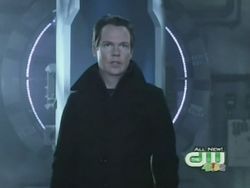
Xaviax and the Mirror Monsters
http://kamenrider.wikia.com/wiki/Xaviax
Xaviax is a scheming conqueror who has placed Ventara under his rule and now seeks to abduct all humans on the Earth as his slaves to rebuild his homeworld of Karsh.
Mirror Monsters function the same as their Ryuki counterparts, only this time they are artificially made soldiers for Xaviax’s army who kidnap humans to mass collect DNA to prefect a long range teleporter to Karsh to abduct all 7 billion humans on Earth and enslave them.
Afterward
Adness tried to make a movie out of Dragon Knight and adapt another Kamen Rider series...but the company could not do it and have gone uncharacteristically quiet, leading some to believe that Adness went bankrupt during the recession. The company did still exist in 2016 (sort of), trying to cash in on Gangam Style by investing in K-Pop....apparently that didn’t work as the official site has gone eerily quiet and the Japan office site has not been updated in 2 years. So either the company is laying dormant or is totally dead. It is as far as we know, a Schrodinger media corporation.
Due to the FCC regulations, angry parents and the rise of internet streaming and cable TV networks not being strict on censorship opening new avenues for creators, Saturday morning kids TV no longer exists as of 2014. But given the modern tech we have, fans can create their own Saturday morning lineups, so if you feel nostalgic for some henshin action by way of adaptation, seek out Dragon Knight.
youtube
Matt Mullins and Stephen Lunsford say: “HENSHIN!” at Power Morphicon in 2010.
#kamen rider#45th anniversary#kamen rider dragon knight#america#tokusatsu#adaptation#kamen rider ryuki#adness#steve wang#saturday morning#cw4kids#henshin#2009
42 notes
·
View notes
Text
10 Brands that Excel at the Art of the Comeback on Social Media
Engaging with audiences on social media is an important part of any brand’s communications strategy. You want your customers to know that you’re listening to them and that you care about their experiences and opinions.
Most of the time, helpful or positive replies are enough to keep your followers happy and build your audience over time.
Sometimes, however, it pays to take a risk. That means sharing content that could spark controversy, thrust your brand into the spotlight, or draw critical attention.
If you do them right, these tactics can pay off big time helping your brand establish its identity, win new followers, or stay ahead of criticism. But they can also lead to disaster.
How can you make sure your brand avoids disaster? By learning from 10 brands that did it right.
Bonus: Get the step-by-step social media strategy guide with pro tips on how to grow your social media presence.
1. Netflix always has a reply for critics
Does anyone not love Netflix on Twitter? Their social media is so good, it almost makes me forget that they no longer have Buffy the Vampire Slayer available to stream.
Even their pre-Christmas bio, a cheeky acknowledgement of one missing holiday classic, shows how well they know their audience:
That’s the key to their success on social: it’s clear that they share their followers’ passion for TV shows and movies. And they’re not afraid to get defend themselves, like when a follower criticized their description of Gossip Girl:
1. Everybody loves Gossip Girl.
2. Where is the lie tho?
— Netflix US (@netflix) December 11, 2018
They don’t play favorites with their programming either. When one follower questioned their retweet of an unconventional routine by Miss Toto from RuPaul’s Drag Race, they didn’t hesitate to reply.
yes.
— Netflix US (@netflix) December 18, 2018
They’re even ready to stand up for the infamous peach scene in “Call Me By Your Name.” That’s how much they love their movies.
quite the opposite.
— Netflix US (@netflix) January 7, 2019
Many brands try to cultivate a suave, cool voice on social media, but Netflix’s responses show that sometimes it pays off to embrace a weirder, nerdier brand voice. Their genuine enthusiasm for TV and movies allows them to connect with fans and followers, and it also helps to promote their content.
2. Merriam-Webster makes the dictionary cool
It might be hard to believe, but one of the best social media accounts out there is run by… the dictionary.
That’s right — the giant book you only crack open to settle Scrabble arguments. Somehow, Merriam-Webster has built a loyal following of more than 725,000 people by tweeting about definitions and grammar.
How did they do it? By seizing opportunities to inform and educate, with a tone that’s funny and confident, like your best English teacher from high school. Here are some of their most cutting clapbacks.
.@dannygonzalez Why don't you look words up before complaining to the dictionary? https://t.co/2HFnO4Y0aY
— Merriam-Webster (@MerriamWebster) January 17, 2017
People keep 1) saying they don't know what 'genderqueer' means
then
2) asking why we added it to the dictionary pic.twitter.com/wsGZ7Y6XB8
— Merriam-Webster (@MerriamWebster) April 25, 2016
If the dictionary can transform their public reputation from a dull reference material to a vital source of trivia and current events, there’s hope for any “boring” brand!
Take it from Merriam-Webster and look for opportunities to share timely, thoughtful content. Use clear language or emojis to make technical information accessible. And don’t be afraid to let your values show through your posts — you may not win everyone’s approval, but you’ll build loyalty and trust with those who choose to follow you.
Oh, and it never hurts to be funny.
We save all our hardcore, heavy metal content for Thursday afternoons. https://t.co/pTLZNSyNS6
— Merriam-Webster (@MerriamWebster) December 13, 2018
3. Sanofi fixes a PR crisis
Pharmaceutical giant Sanofi experienced every company’s worst nightmare when they were thrust into the center of a PR scandal in May 2018. Actress Roseanne Barr blamed sending several racist tweets on her use of the sleep aid Ambien, which is made by Sanofi.
Rather than trying to dodge the spotlight, the company responded swiftly to her remarks with a strong position of their own:
People of all races, religions and nationalities work at Sanofi every day to improve the lives of people around the world. While all pharmaceutical treatments have side effects, racism is not a known side effect of any Sanofi medication.
— Sanofi US (@SanofiUS) May 30, 2018
Their response went viral and garnered overwhelmingly positive responses. While they could have stayed silent and wait for the next medial scandal to redirect public attention, their decision to respond allowed them to turn a disaster into a win.
Keep hoping that your brand is never associated with a celebrity’s public meltdown, but just in case, it’s important to have a plan in place.
4. MoonPies seizes the mo(on)ment
The August 2017 eclipse was a rare cosmic event, and a lot of companies attempted to ride the coattails of public excitement with stunt advertising campaigns. But few were as perfectly positioned to do so than the aptly-named MoonPies. Rather than pulling together a big campaign of their own, they managed to achieve a massive impact with a single tweet:
Lol ok https://t.co/lobyuNOkee
— MoonPie (@MoonPie) August 21, 2017
It’s always a good idea to take note of upcoming occasions and events that align with your brand (a content calendar can help you there!). These are perfect opportunities to boost your visibility in the public eye and gain new followers.
But MoonPies proves that sometimes there’s value in a less-is-more approach. Rather than competing with rival campaigns, MoonPies broke through the noise with a funny, irreverent message.
5. Adidas owns up to an insensitive email
Is there a more awful feeling than realizing that you just said something really insensitive a moment too late? Adidas knows how you feel.
In April 2017, they sent an email to select customers with the subject line, “Congrats, you survived the Boston Marathon!”
While most would agree that running a marathon is an impressive feat of stamina, their phrasing inadvertently made light of the devastating Boston Marathon bombing in 2013.
My friend received this email from Adidas after the Boston Marathon… I don't know how an advertising team doesn't catch this. pic.twitter.com/Fe16Z4Hnvq
— Robin Dich (@RobinDich) April 18, 2017
Rather than minimizing or ignoring the situation, Adidas swiftly issued an apology.
pic.twitter.com/cdBKixwSqT
— adidas (@adidasUS) April 18, 2017
While publicly apologizing could have drawn even more attention to their faux-pas, Adidas managed to strike the right balance with their message. They didn’t deflect or minimize the impact, and they take responsibility as a company for the mistake.
As proof of public forgiveness, the ratio on their apology tweet is excellent. People on social media are quick to pile on when it comes to a public blunder, but a genuine and thoughtful apology can go a long way to restoring your brand’s good name.
Bonus: Get the step-by-step social media strategy guide with pro tips on how to grow your social media presence.
Get the free guide right now!
6. Wendy’s is the reigning clapback champion
No roundup of social media comebacks would be complete without mention of Wendy’s, which may now be better known for their online sass than their Junior Bacon Cheeseburgers. They even wrote a blog post, patting themselves on the back for their best 2018 Twitter roasts.
Not really afraid of the burgers from a place that decided pancakes were too hard.
— FREEBACONATOR (@Wendys) June 11, 2018
Fast food restaurants are a competitive bunch when it comes to social media sass, but Wendy’s is the undisputed champ, always ready with a witty response.
@Wendys thoughts on @IHOb ?
— Gabe Kapler’s Coconut Oil (@GabeKaplersOil) June 11, 2018
Their strategy can’t work for everyone; Wendy’s has built their online reputation on being snarky, and 2.9 million people follow them for their merciless burns. Before you follow their lead, make sure sarcasm is true to your brand voice.
7. The MERL gains popularity with humor
Why does a small museum about the English countryside have more than 80,000 followers on Twitter? Because unlike other tiny museums about mundane subjects, this one knows how to build a brand using social media!
The MERL (Museum of English Rural Life) first emerged from internet obscurity in April 2018 with a delightful riff on the “absolute unit” meme. Even if you’re not a scholar of internet humor, you can still appreciate the artistry:
look at this absolute unit. pic.twitter.com/LzcQ4x0q38
— The Museum of English Rural Life (@TheMERL) April 9, 2018
Twitter users came for the chubby sheep joke and stayed when they realized this museum (and its collection of old farm photos) was absurdly funny. Suddenly, we were all fans of rural British life.
me at xmas dinner: just a couple roast potatoes please being good this year
me 5 mins later: pic.twitter.com/W93gtEQAh0
— The Museum of English Rural Life (@TheMERL) December 19, 2018
Just as marketers since time immemorial (or, okay, since the early 2000s) have tried to predict what content will go viral, social media managers are always trying to nail the formula for the perfect post.
In part, their tweets work because they’re so unexpected — who would think a museum account could be so weird and hilarious? But also, their content works because it’s unique. They’re drawing inspiration from their own archives and collections, which means their posts aren’t like anything else you’ll find on Twitter.
At the end of the day, social media users care about the quality and originality of content above anything else. If you’re sharing funny, interesting, or visually striking content, you’ll find your audience.
8. KFC proves that honesty is the best policy
In February 2018, KFC turned a PR disaster into a major win when 750 of their restaurants in the UK and Ireland closed suddenly due to a supply issue.
Fried chicken fans were livid. Local authorities even had to remind the public that a fried chicken shortage was not a valid reason to call the police.
How did they fix the fiasco? By taking responsibility, admitting fault, and being transparent about the issue.
In addition to setting up a website where customers could check if restaurants had reopened yet, and taking out some profane print ads to apologize, they also kept their social media followers in the loop.
There's gossip in the hen house, here's the facts… pic.twitter.com/lEuyiOZx2h
— KFC UK & Ireland (@KFC_UKI) February 21, 2018
Good news, over half of our restaurants are now back open! Our teams are working flat out to open the rest. Equilibrium will soon be restored. pic.twitter.com/ZXgijpBR7L
— KFC UK & Ireland (@KFC_UKI) February 20, 2018
As the head of brand engagement Jenny Packham said, KFC decided to “remain true to its brand voice” and apologize to customers, rather than hide behind a formal statement or point fingers at the supplier.
As a result, their fans and customers felt like there were real people trying to fix the problem, not just a faceless company trying to minimize a major problem.
9. Patagonia defends their environmental values
Outdoor retailer Patagonia is well-known for their corporate values around sustainability. And they’re willing to defend their reputation as environmental stewards when customers question their commitment:
Considering they are printed on 100% recycled paper with non-toxic ink, we do think that it's worth it to share our stories and photos with our customers. If you'd like to be removed please send your name, address, and customer number to [email protected]
— Patagonia (@patagonia) November 30, 2018
We didn't have a Black Friday sale as it promotes buying more which promotes more waste.
— Patagonia (@patagonia) November 30, 2018
But they brought new attention to their cause when CEO Rose Marcario announced on LinkedIn that the company was donating their $10 million tax cut—the result of changes to corporate tax rates administered by the Trump administration—to environmental causes. While many companies avoid wading into political territory, Patagonia took direct aim at Donald Trump with this comeback, calling the corporate tax cut “irresponsible.”
The tax cut is a contentious political issue, and their bold response did generate some criticism. But it ultimately drew a huge amount of positive attention to their company and practices, and reinforced their brand values.
Customers increasingly consider company values when choosing between brands. If you want to set yourself apart from your competitors, making it clear what your company stands for can be a smart strategy.
10. KLM improves the traveler experience
Airlines have it rough on social media. By my unscientific estimate, ninety-nine per cent of all messages they receive are from disgruntled passengers who are mad about flight delays, lost luggage, and disappointing mid-flight snacks. They’re a hard bunch to appease, but Dutch airline KLM does it better than anyone else.
In 2014, they launched a campaign to encourage customers to reach out on social media if they had lost items during transit. It kicked off with an adorable video featuring a dog named Sherlock returning forgotten possessions to happy travelers, which racked up over 24 million views.
Unfortunately, Sherlock isn’t actually checking flights for your forgotten headphones, but KLM flight attendants are. And customers still regularly contact KLM for assistance.
Big thanks to @KLM and the wonderful lost+found crew who found my #amazon #kindle and returned to me before flight today pic.twitter.com/uMvipnsHeW
— Andrew Lombardi (@kinabalu) October 17, 2017
Me: I’ll just leave my laptop in the seat pocket in front and have a quick nap before we land. ????
Also me: OMG I LEFT MY LAPTOP ON THAT PLANE ????
Fortunately, @KLM’s lost & found team & @Schiphol airport retrieved my trusty mobile office in under 20 minutes. ????
Thanks guys! ????
— Luc Dockendorf (@LucDockendorf) June 12, 2018
Promoting this option to customers has two benefits for the airline: it generates positive stories about returned items, and demonstrates their commitment to customer service.
Hello Nick, we would like to request our KLM Lost & Found Team to start a search for your lost item. Please send a Direct Message for this. Thank you!
— Royal Dutch Airlines (@KLM) September 10, 2018
It also clarifies how their social media team can assist customers. People often tweet at brands asking for help with problems that can’t be addressed in a tweet or a Facebook message, leaving the customer angry and unsatisfied with their unresolved issue. By telling people what their social media team can do, KLM has set themselves up for success.
Inspired by these comebacks? Use Hootsuite to monitor all relevant conversations and engage your audience (with a bit sass, if appropriate). Try it free today.
Learn More
The post 10 Brands that Excel at the Art of the Comeback on Social Media appeared first on Hootsuite Social Media Management.
10 Brands that Excel at the Art of the Comeback on Social Media published first on https://getfblike.tumblr.com/
0 notes
Text
#Don #Henley #Biography #Photos #Wallpapers #photooftheday #fashionphotography #red #streetstyle #summer #swag #theferragnis #threads #travel #wshh
With earlier mentioned 100 million in list sales, the Eagles epitomized commercial Southern California rock in the 1970s, and their appeal continues undiminished decades later. As of late 2007, Their Greatest Hits 1971-1975, a 1976 best-of that was the first album ever certified platinum, is the best-selling album of all time in the U.S., its 29 million copies outstripping the previous champ, Michael Jackson’s Thriller (27 million). The group’s well-crafted songs merged countryish vocal harmonies with hard-rock guitars and lyrics that were alternately yearning (“One of These Nights,” “Best of My Love”) and romantically jaded (“Life in the Fast Lane,” “Hotel California”). During the band’s hugely successful career, it had an increasingly indolent recording schedule until its breakup in the fall of 1980. Subsequently, every single of the members pursued solo careers, with Henley’s the most successful commercially and critically. In the 1990s, the band’s sound was frequently cited as an influence by young country stars and culminated with the band’s reunion in 1994. The Eagles continue to be one of clean millennium’s most successful bands.
The group originally coalesced from L.A.’s country-rock community. Before producer John Boylan assembled them as Linda Ronstadt’s backup band on her album Silk Purse (1970), the four original Eagles were already experienced professionals. Leadon had played in the Dillard and Clark Expedition and the Flying Burrito Brothers; Meisner, with Poco and Rick Nelson’s Stone Canyon Band. Frey had played with various Detroit rock bands (including Bob Seger’s) and Longbranch Pennywhistle (with J.D. Souther, a sometime songwriting partner), and Henley had been with a transplanted Texas group, Shiloh. After working with Ronstadt, Henley and Frey decided to form the Eagles, recruiting Leadon and Meisner.
Intending to take the country rock of the Byrds and Burritos a step further toward hard rock, the Eagles recorded their first album with producer Glyn Johns (Rolling Stones, the Who) in England. “Take It Easy” (Number 12, 1972), written by Frey and Jackson Browne, went gold before long after its release, as did their album. (Another single, “Witchy Woman,” reached Number Nine that year.) Desperado was a concept album with enough of a plot line to encourage rumors of a movie version. The LP yielded no major pop hits, but its title track, a ballad penned by Henley and Frey, has become a classic rock standard, covered by Linda Ronstadt, among others. With On the Border, the Eagles changed producers, bringing in Bill Szymczyk (who worked on all subsequent albums through 1982’s Greatest Hits Vol. 2) and adding Felder, who had recorded with Flow in Gainesville, Florida (and who once gave guitar lessons to another Gainesville native, Tom Petty), then became a session guitarist and studio engineer in New York, Boston, and L.A.
The increased emphasis on rock attracted far more listeners — mid-1970s hits included “Best of My Love” (Number One, 1975), “One of These Nights” (Number One, 1975), “Lyin’ Eyes” (Number Two, 1975), and “Take It to the Limit” (Number Four, 1975) — but alienated Leadon. After One of These Nights, Leadon left the band to form the Bernie Leadon-Michael Georgiades Band, which released Natural Progressions in 1977. (Leadon went on to become a Nashville session musician, and in the 1990s formed Run-C&W, a jokester group who played a blend of country and R&B.)
Leadon was replaced by Joe Walsh, who had established himself with the James Gang and on his own. His Eagles debut, Hotel California, was their third consecutive Number One album (the second was their record-breaking 1976 greatest-hits compilation). “New Kid in Town” (Number One, 1976), the title cut (Number One, 1977), and “Life in the Fast Lane” (#11, 1977) spurred sales of more than 16 million copies worldwide.
Meisner left in 1977, replaced by Schmit, who had similarly replaced him in Poco. Meisner has released the solo albums Randy Meisner (1978) and One More Song (1980), and (yes) Randy Meisner (1982). (In 1981, he toured with the Silveradoes; later, in 1990, Meisner reemerged in a group called Black Tie, alongside Billy Swan and Bread’s James Griffin.) Henley and Frey sang backup on One More Song, and in the late 1970s they also appeared on album by Bob Seger and Randy Newman. In 1981 Henley duetted with Stevie Nicks on the Number Six single “Leather and Lace.”
Between outside projects and legal entanglements, it took the Eagles two years and $1 million to make the multi-platinum LP The Long Run. The album included the hit singles “Heartache Tonight” (Number One, 1979), “The Long Run” (Number Eight, 1980), and “I Can’t Tell You Why” (Number One, 1980).
Walsh continued to release solo albums, though his biggest hit to date has been 1978’s cheeky “Life’s Been Good” (Number 12). Felder and Schmit also put out their own albums and contributed songs to film soundtracks. Schmit’s second LP, Timothy B, included “Boys Night Out” (Number 25, 1987).
In 1982 Henley and Frey both embarked on solo careers. Frey charted with “The One You Love” (Number 15, 1982) and “Sexy Girl” (Number 20, 1984) before a movie proved his ticket into the Top Ten: “The Heat Is On,” featured in Beverly Hills Cop, shot to Number Two in 1985. Frey followed this success by becoming an actor, making a guest appearance as a drug dealer on the popular TV series Miami Vice. The episode was based on a track from his album The Allnighter, “Smuggler’s Blues,” which consequently reached Number 12 (1985). Later in 1985, Frey’s “You Belong to the City” hit Number Two. While still dabbling in acting with roles in the short-lived TV series South of Sunset, the movie Jerry Maguire, and a guest spot on the Don Johnson post-Miami Vice series Nash Bridges in the 1990s, Frey also co-founded a music label, Mission Records, in 1997.
Ultimately, though, Henley was the ex-Eagle who garnered the greatest chart success, and the most critical acclaim as well. His “Dirty Laundry” (from his first solo effort, I Can’t Stand Still) made it to Number Three, but the 1985 solo album Building the Perfect Beast was to be his true arrival as solo hit maker and respected singer/songwriter. The kickoff single, “The Boys of Summer,” went to Number Five — supported by an evocative black-and-white video that fast became an MTV favorite — and earned Henley a Grammy for Best Rock Vocal Performance; the hits “All She Wants to Do Is Dance” (Number Nine, 1985) and “Sunset Grill” Number 22, 1985) followed. A third album, The End of the Innocence (1989), created a Number Eight (1989) title track, and the additional singles “The Last Worthless Evening” and “The Heart of the Matter,” which both hit Number 21. The LP won Henley another Grammy, in the same category as before.
In the early 1990s, he sought release from his Geffen Records contract, initiating a long and bitter legal dispute. After participating in the release of a solo best-of album in 1995, Henley was freed from his contract. Five years later, he released a solo album of all-new material, Inside Job (co-produced by former Tom Petty and the Heartbreakers drummer Stan Lynch), and embarked on a solo tour to support it. Henley married for the first time in May 1995 and had three children before releasing Inside Job. This life-altering change for the longtime bachelor resulted in a new theme in his songwriting; a lot of of Inside Job’s tracks were clearly about marriage and family, including the gentle ballad “Taking You Home” (Number 58 pop, Number One Adult Contemporary, 2000). Much of the rest of the album, however, still explored Henley’s cynicism toward the business world and the media.
In 1990 Henley founded the Walden Woods Project, dedicated to preserving historic lands around Walden Pond in Concord, Massachusetts (where Henry David Thoreau and others reflected and wrote), from corporate development. Among the singer’s various fund-raising means were holding charity concerts, featuring other top rock artists, and donating proceeds from some of his own recordings, including a reggae version of the Guys and Dolls standard “Sit Down You’re Rocking the Boat” (1993). In 1993 the Walden Woods Project got a big increase from Common Thread: The Songs of the Eagles, coordinated by Henley and featuring Clint Black, Trisha Yearwood, Travis Tritt, and others.
In 1994, after years of fielding off reunion rumors, Henley, Frey, Walsh, Felder, and Schmit — who had appeared together in the video for Tritt’s version of “Take It Easy” — hit the road for a massively successful concert tour. The tour went on hiatus toward the end of 1994, due to Frey’s gastrointestinal surgery, but it continued in 1995. In November 1994, the band released Hell Freezes Over, which featured four new songs, including the singles “Get Over It” (Number 31, 1994), “Love Will Keep Us Alive” (Number One Adult Contemporary, 1994), “Learn to Be Still” (Number 15 Adult Contemporary, 1995), and 11 of the old hits culled from the band’s 1994 live appearance on MTV. Within months the reunion LP had sold more than 10 million copies and gone to Number One on the pop album chart.
In 1998 the Eagles were inducted into the Rock and Roll Hall of Fame. All seven members of the band performed together for the first time at the induction ceremony. The core members of the group — the ones who had recorded and toured together in the mid-1990s — reunited again for a few concerts at the end of 1999, including a New Year’s Eve show in L.A. A four-CD retrospective set, Eagles 1972-1999: Selected Works (Number 109) was issued in November 2000. In February 2001, the Eagles fired Felder, who retaliated by suing the band, its organization, and Henley and Frey individually; the latter pair countersued. (Felder later wrote a book about his time in the band, Heaven and Hell, which was published in the U.K. in November 2007.) The case was settled out of court in May 2007.
In 2003, The Very Best of the Eagles was released, covering the band’s full 1970s output as well as the new single “Hole in the World.” In 2007, Eagles released its first all-new album in 28 years, the double-CD Long Road Out of Eden, exclusively through Wal-Mart, Sam’s Club, and Eagles.com in the U.S. It debuted at Number One on the Billboard chart. The band continued to tour successfully through 2008.
Name Don Henley Height 5' 10 Naionality U.S Date of Birth July 22, 1947 Place of Birth Gilmer, Texas, US Famous for Pop/rock singer
The post Don Henley Biography Photos Wallpapers appeared first on Beautiful Women.
source http://topbeautifulwomen.com/don-henley-biography-photos-wallpapers/
0 notes